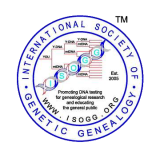The Seven Daughters of Eve
From ISOGG Wiki
(Redirected from Seven Daughters of Eve)The Seven Daughters of Eve is a book by Bryan Sykes which presents the theory of human mitochondrial genetics to a general audience. Sykes explains the principles of genetics and human evolution, the particularities of mitochondrial genetics, and analyses of ancient DNA to genetically link modern humans to prehistoric ancestors.
Following the developments of mitochondrial genetics, Sykes traces back human migrations, discusses the "Out of Africa theory" and refutes Thor Heyerdahl's theory of the Peruvian origin of the Polynesians, which opposed the theory of their origin in Indonesia. He also describes the use of mitochondrial DNA in identifying the remains of Czar Nicholas II, and in assessing the genetic makeup of modern Europe.
The title of the book comes from one of the principal achievements of mitochondrial genetics, which is the classification of all modern Europeans into seven groups, the mitochondrial haplogroups. Each haplogroup is defined by set of characteristic mutations on the mitochondrial genome, and can be traced along a person's maternal line to a specific prehistoric woman. Sykes refers to these women as "clan mothers", though these women did not all live concurrently. Indeed some "clan mothers" are descended from others (although not maternally). All these women in turn shared a common maternal ancestor, known as Mitochondrial Eve.
The last third of the book is spent on a series of fictional narratives, written by Sykes, describing his creative guesses about the lives of each of these seven "clan mothers". This latter half generally met with mixed reviews in comparison with the first part.
Contents
Mitochondrial haplogroups in The Seven Daughters of Eve
The seven "clan mothers" mentioned by Sykes each correspond to one (or more) human mitochondrial haplogroups.
- Helena: corresponds to Haplogroup H
- Jasmine: corresponds to Haplogroup J
- Katrine: corresponds to Haplogroup K
- Tara: corresponds to Haplogroup T
- Ursula: corresponds to Haplogroup U (specifically U5, and excluding its subgroup K)
- Velda: corresponds to Haplogroup V
- Xenia: corresponds to Haplogroup X
Additional daughters
Sykes had claimed there were seven major mitochondrial lineages for modern Europeans but others now put the number at 10-12. These additional "daughters" generally include Haplogroup I, Haplogroup M and Haplogroup W.[1]. A recent paper re-mapped European haplogroups as H, J, K, N1, T, U4, U5, V, X and W.[2]
Likewise, Sykes has invented names for an additional 29 "clan mothers" worldwide, each corresponding to a different haplogroup identified by geneticists: Fufei, Ina, Aiyana/Ai, Yumi, Nene, Naomi, Una, Uta, Ulrike (Haplogroup U4), Uma, Ulla, Ulaana, Lara, Lamia, Lalamika, Latasha, Malaxshmi, Emiko, Gaia, Chochmingwu/Chie, Djigonasee/Sachi, Makeda, Lingaire, Lubaya, Limber, Lila, Lungile, Latifa and Layla."[3]
References
- Bryan Sykes. The Seven Daughters of Eve: The Science That Reveals Our Genetic Ancestry. W.W. Norton, 2001, hardcover, 306 pages.
Reviews
| This article is licensed under the GNU Free Documentation Licence. It uses material from the Wikipedia article "The Seven Daughters of Eve". |
